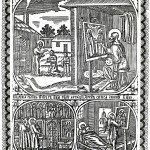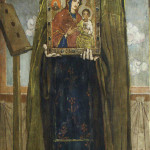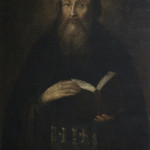Онлайн трансляция | 12 сентября
Название трансляции
- 12 сентября 2015 Название трансляции
- 12 сентября 2015 Название трансляции
- 12 сентября 2015 Название трансляции
- 12 сентября 2015 Название трансляции
- 12 сентября 2015 Название трансляции
- 12 сентября 2015 Название трансляции
- 12 сентября 2015 Название трансляции
- 12 сентября 2015 Название трансляции
Rev. Alipius, The Icon Painter
The Near Caves

Memorial day on August the 30th
Our holy father Alipius of the Caves was the follower of St. Luke the Evangelist. He wondrously depicted the faces of saints on icons. At the same time, many of their virtues were imprinted in his soul. Besides, St. Alipius was a wonderworking healer.
In the reign of the faithful Prince Vsevolod Yaroslavovich of Kiev, in the abbacy of St. Nikon, God called Greek icon painters from Constantinople to the Cave Monastery. St. Alipius’ parents gave the youth over to the icon painters for him to learn their art. While working with them, the young man witnessed an unbelievable miracle: when the masters were painting in the sanctuary the icon of the Most Holy Theotokos appeared spontaneously, shining like the sun; the dove flew out of Her mouth and flew into the mouth of the Saviour on the nearby icon. From that time, St. Alipius knew that the Holy Spirit abided at the Cave church.
After the church had been decorated, St. Alipius received the Holy Sacrament of tonsure from the abbot, St. Nikon. His iconographic skills continued to develop.
The monk mastered iconography for the sake of gaining virtues but not for his own enrichment. By God’s grace, St. Alipius was able to depict virtuous images of saints on their icons. He painted icons free for anyone who asked. The saint was never idle; by his hard work he imitated the ancient fathers who never ceased their handicraft works.
 If the saint happened to get a reward for his work, he divided it into the three equal parts: for materials for icons, for the poor and for the needs of the monastery. He gave himself rest neither day nor night; at night, he remained in vigil, praying with endless prostrations. Admitting all these virtues in the saint icon painter, the abbot decided to elevate him to the priesthood. St. Alipius became as a lamp placed upon a lamp stand; he increased the beauty of the priesthood with pure monastic virtues. He became known for his wonderworking.
If the saint happened to get a reward for his work, he divided it into the three equal parts: for materials for icons, for the poor and for the needs of the monastery. He gave himself rest neither day nor night; at night, he remained in vigil, praying with endless prostrations. Admitting all these virtues in the saint icon painter, the abbot decided to elevate him to the priesthood. St. Alipius became as a lamp placed upon a lamp stand; he increased the beauty of the priesthood with pure monastic virtues. He became known for his wonderworking.
A wealthy citizen of Kiev suffered from leprosy. He sought for help from various doctors, magi, sorcerer, and even heterodox healers, but they brought him no relief. He was getting even worse. Then, one of his friends advised him to go to the Cave Monastery and ask the fathers for help. The ill man did not really take the advice seriously and set out for the Caves almost unwillingly. When he arrived, the abbot ordered the brothers to give him some water to drink from the well of St. Theodosius and to anoint his head and face.
After that, the horrible sores on his body became terribly inflamed and an unbearable stench began to spread around him; it drove away everybody approaching him. The unfortunate man returned home weeping and lamenting over his illness. For several days, he did not even appear in the daylight. Finally, he told his friends, ‘This woe occurred because I went to the holy fathers Anthony and Theodosius with unbelief.’
Broken by his grief and sorrow, the man daily awaited for his death. Finally, however, he came to his senses and decided to confess his sins. He somehow managed to get to the Cave Monastery and confessed to St. Alipius. The saint told him, ‘You have done well to confess your sins to God, before my unworthy self, for so did the prophet, Into Your hand I commit my spirit; You have ransomed me, Oh Lord, God of truth (Ps. 31, 5).
The saint taught the repentant sinner how he could save his soul. Later, he anointed the  putrid sores with some iconographic paint. St. Alipius took the man to the church, gave him the Holy Communion and ordered him to wash his face with water used by the priests to wash their faces after the Communion. The scabs immediately fell off his skin and the healthy complexion returned to his face. Thus, our holy father Alipius was a wonderworker following Jesus Christ. Christ had healed the leper and then ordered him to bring an offering for his cleansing before the priests; in the same way St. Alipius ordered the leper to come before the priests and bring a gift of which the prophet speaks, What shall I return to Lord for all his goodness to me? I will lift up the cup of salvation (Ps. 115, 3-4).
putrid sores with some iconographic paint. St. Alipius took the man to the church, gave him the Holy Communion and ordered him to wash his face with water used by the priests to wash their faces after the Communion. The scabs immediately fell off his skin and the healthy complexion returned to his face. Thus, our holy father Alipius was a wonderworker following Jesus Christ. Christ had healed the leper and then ordered him to bring an offering for his cleansing before the priests; in the same way St. Alipius ordered the leper to come before the priests and bring a gift of which the prophet speaks, What shall I return to Lord for all his goodness to me? I will lift up the cup of salvation (Ps. 115, 3-4).
Moreover, Jesus Christ healed a young man who had been born blind, by anointing his eyes with clay and then sending him to wash in the Pool of Siloam. St. Alipius did likewise with the leprous man. Those who had come to the monastery with the ill marvelled at his healing and Saint Alipius told them,
‘Brethren! Heed what is said, No one can serve two masters (Mt. 6, 24). For this man had previously been a slave of sin and applied to magic first. Later, he came here to God but was careless in his salvation and did not believe in the Lord Who is the only Saviour.
Therefore, his illness grew stronger and attacked him all the worse because of his unbelief, for the Lord said, But when he asks, he must believe and not doubt (Mt. 7, 7).
And here, when the sinner was converted, bringing repentance to God for his sin of unbelief, God in His rich mercy healed him,’
Having heard that, people bowed and went away with the healed man glorifying God, His Holy Mother, Reverend Fathers Anthony and Theodosius as well as their disciple, St. Alipius.
There was a Christ-loving man in Kiev who had built a church and wished to decorate it with seven large icons. He gave some silver and icon boards to two monks of the Cave Monastery and asked them to talk to St. Alipius about painting of the icons. The monks, however, said nothing to St. Alipius but kept the silver. In some time, the man who had ordered the icons sent his servants to see the monks and inquire about the icons. They replied that St. Alipius required more silver. The man sent the required material but the monks kept it again. Bringing falsehood upon the saint, they came to the man again saying that St. Alipius required as much silver as he had already received. The Christ-loving man gave them silver for the third time saying, ‘I only want his prayers and blessing from the work of his hands.’
St Alipius knew nothing of the brothers’ deeds. After a while, the man sent to find out whether his icons were painted. The monks were confused; they replied that St. Alipius had taken the three measures of silver but refused to paint the icons. When the man heard that, he set out to the monastery with several retainers to see abbot Nikon and tell him of the offence from St. Alipius. The abbot called for the saint and asked, ‘Why have you been untruthful with our son? He approached you many times and gave you as much silver as you wanted, and you took the silver but do not paint the icons as promised. What does this all mean? You often paint icons for free.’
St Alipius replied, ‘Honourable Father! Your holiness knows that I have never shown laziness in my work; I do not know what you are talking about.’
 The abbot told him again that he had received three measures of silver for seven icons and still had not painted them. He sent for the icon boards provided by the customer. The boards had been seen a day before in a storeroom; there
The abbot told him again that he had received three measures of silver for seven icons and still had not painted them. He sent for the icon boards provided by the customer. The boards had been seen a day before in a storeroom; there
was no painting on them. The monks receiving the order were invited as witnesses. The brothers that were sent for the boards came to the storeroom and, instead of plain boards, they saw seven beautifully painted icons there. They brought them to the room where the abbot and those gathered had been waiting. Everyone fell trembling down face to the floor in astonishment. They reverenced to the miraculous icons. Meanwhile, the two slanderers arrived knowing nothing of the miracle. They began to accuse St. Alipius that he had taken the three measures of silver but did not paint the icons. At this, the wondrous icons were brought forth and the abbot said, ‘Here now are these icons, painted by God Himself Who testifies of Alipius’ meekness.’ When they saw the miracle they were horrified. The abbot reproached them for their unjust deed and sent them out of the monastery.
Still, those two monks did not repent of their evilness, for they began to spread slander against St. Alipius in the city and they even slandered the icons. Some people believed the two former monks. God, however, glorified His saint as He Himself said in the Gospel, A city upon a mountain top cannot be hidden nor is a light lighted under a bushel but is placed on a stand to give light to everyone. He did not conceal the virtuous struggles of this righteous man. The miracle of the icons which God worked for the sake of His saint, was made known to Prince Vladimir Monomakh and confirmed by the following event,
It once happened that the Podol district of Kiev burned down. The church where the seven miraculous icons were kept was also burned. After the fire, the icons were found completely unharmed. The fact was reported to the prince and he came to see the miracle. Hearing how they were painted in one night by God’s will in order to justify St. Alipius, Vladimir Monomakh glorified God. The prince took one of these icons, the one of Theotokos, and sent it to the new stone church built in Rostov. The icon was miraculously preserved in two similar occasions.
Another pious man gave St. Alipius a commission to paint an icon of the Dormition of the Most Holy Theotokos and asked him to have it completed by the holiday of the Dormition. The saint fell ill and in several days it was clear that he was approaching his final repose. So, he could not fulfil the commission to paint the icon. The person was upset and indignant with the saint but St. Alipius told him, ‘Child, do not bring your grief to me. Raise your grief to the Lord and He will do as He wills. The icon will be in place for the holiday.’
The man accepted the saint’s words and went home rejoiced. The day before the Dormition, he came again and saw that the icon was not painted yet and that St. Alipius got worse. The man reproved him saying, ‘Why did you not inform me that your illness was so serious? I would have found someone else to paint the icon for the holiday might be bright and honourable, but now you have ashamed me.’
The meek saint replied, ‘Child, could it be that I do this through laziness? Remember that God can, by a single word, paint the icon of His Mother. I am departing from this world soon and the Lord has revealed to me that you shall not be left sorrowful.’
The man left in grief. Soon after he had left, an angel appeared in the cell of St. Alipius; he began to paint the icon. Within three hours the heavenly painter painted a wondrous icon. Then he said to the saint, ‘Father, what is missing here and what did I do wrong?’
The saint answered, ‘You have done well. God helped you to paint so beautifully. He Himself painted with your hands.’
The painter vanished with the icon. The man who had ordered the icon spent the entire night in grief, because the icon would not be ready for the holiday. In the morning, he arose and set out for the church in order to weep over his sins, as his the church was deprived of the icon. He opened the door and, in amazement, saw the icon in its place shining heavenly. He fell to the floor in fear thinking that he saw an apparition. Raising his head a little, he looked and realized that this was truly the icon. Trembling with awe, he recalled the words of St. Alipius who said that the icon would be ready for its holiday. With joy, he went home and informed his household. They all went to the church with candles and censers; seeing the shining icon people fell face down on the floor in reverence. After that, the pious man went to the abbot and told him of the miracle with the icon. They all went to St. Alipius’ cell; the saint was ready to leave this world. The abbot asked him, ‘Father! How and who painted the icon?’
The saint told them that he had seen an angel painting the icon. That same angel was there, ready to take him away. With these words the saint gave up his soul into the hands of the Lord on August 17 (by old style). The brethren tidied his body, carried it into the church and, having chanted the service over him, placed him in the cave of St. Anthony. Thus, the holy wonderworking icon painter adorned heaven and earth, honouring the Icon painter-creator, God the Father, Who said, Let Us make man in Our image, after Our likeness (Gen. 1, 26) and the image of His Incarnation, God the Son, Who took on the image Himself together with the Holy Spirit Who came down in the image of a dove and of fiery tongues. May we in unison with the Holy Father Alipius, praise Them Who are One in Essence in endless ages of ages. Amen!